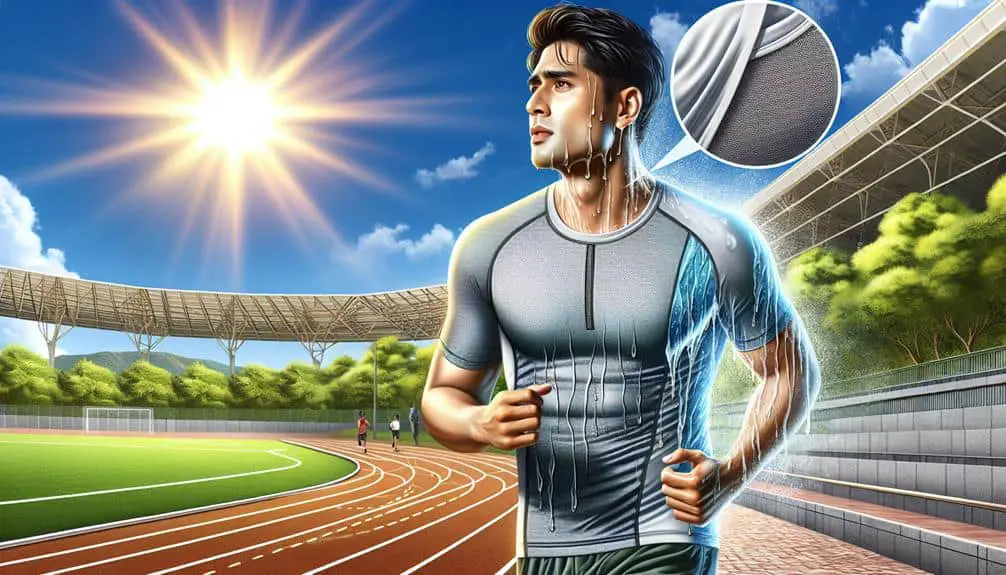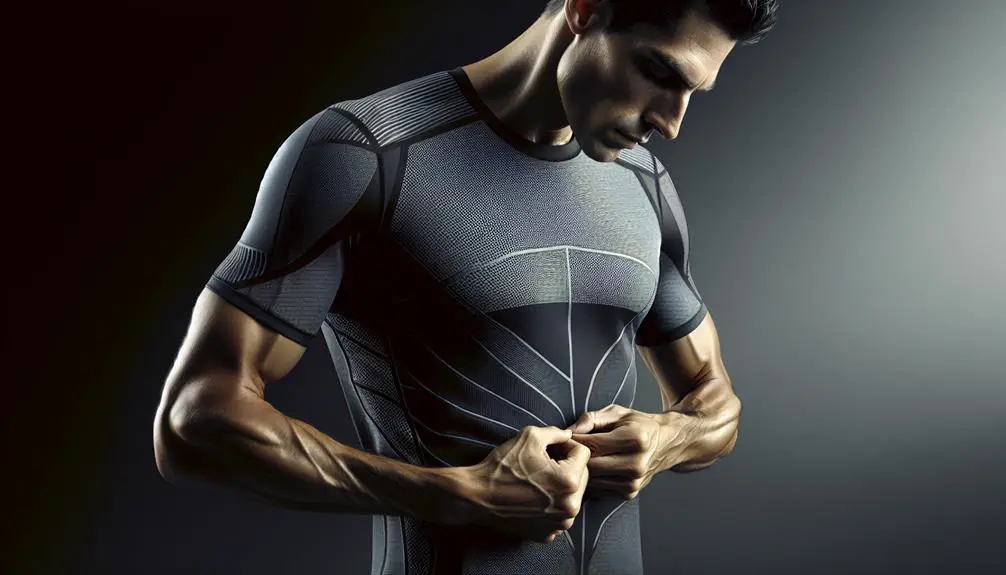Maximize your activewear's performance with expert advice. Choose fabrics like polyester and nylon for their moisture-wicking properties. Assure a snug fit and strategic seam placement for effective moisture control. Follow care instructions to maintain fabric quality. Layer strategically and opt for breathable accessories. Stay hydrated and consider sweat-proof makeup. Enhance your workout experience by implementing these moisture management best practices.
Key Points
- Choose synthetic fabrics like polyester or nylon for superior moisture-wicking capabilities.
- Ensure a proper fit to prevent excess fabric from holding moisture and reduce chafing.
- Follow manufacturer's care instructions to maintain fabric integrity and longevity.
- Utilize layering techniques and breathable accessories for effective moisture management.
- Stay hydrated, opt for sweat-proof makeup, and focus on strategic ventilation for peak performance.
Understanding Moisture Wicking Technology
To enhance your understanding of moisture-wicking technology, let's explore the intricate mechanisms that enable activewear to efficiently manage sweat during physical activity. Fabric composition plays a vital role in this process. Activewear designed for moisture management typically utilizes synthetic fabrics like polyester or nylon. These materials are hydrophobic, meaning they repel water, allowing sweat to be pulled away from your skin and towards the outer surface of the garment.
Sweat absorption is another key aspect of moisture-wicking technology. The fabric's composition is engineered to have tiny gaps or micropores, which create capillary action. This capillary action enables the fabric to draw sweat away from your body and spread it out across a larger surface area, allowing for quicker evaporation. As a result, you stay drier and more comfortable during your workout.
Understanding how fabric composition and sweat absorption work together in moisture-wicking technology is essential for selecting activewear that will keep you dry and cool during intense physical activities.
Choosing the Right Fabric
Selecting the appropriate fabric is essential when considering moisture management in activewear. Fabric selection plays a pivotal role in the performance of activewear regarding moisture control and breathability.
To maximize moisture management, choose fabrics that have excellent moisture-wicking properties. Fabrics like polyester, nylon, and spandex are popular choices due to their ability to wick moisture away from the skin and dry quickly, keeping you comfortable during physical activities. These materials also offer good breathability, allowing sweat to evaporate easily, preventing the build-up of moisture and enhancing overall comfort.
Mesh fabrics are another excellent option for activewear, as they provide enhanced ventilation and airflow, aiding in moisture evaporation. When selecting activewear fabrics, prioritize those that not only offer moisture control but also promote breathability to ensure peak performance during workouts.
Proper Fit for Effective Moisture Control
For essential moisture control in activewear, guaranteeing a proper fit is vital to enhance performance and comfort during physical activities. Proper sizing and tailoring play a significant role in maximizing the benefits of moisture-wicking fabrics.
Here are four key points to ponder:
- Eliminate Excess Fabric: A snug fit prevents surplus fabric from holding onto moisture, allowing the garment to efficiently wick sweat away from your body.
- Strategic Seams: Opt for activewear with strategic seam placement that reduces chafing and irritation. Well-placed seams can enhance the overall fit and comfort of the garment.
- Freedom of Movement: Ensure the activewear allows for a full range of motion without being too loose or restrictive. This balance is crucial for both performance and moisture control.
- Proper Hem Length: Pay attention to the length of tops and bottoms to prevent them from riding up or down during activities. Proper hem length contributes to a comfortable fit that aids in moisture management.
Washing and Care Instructions
When considering the maintenance of your activewear, adhere to specific washing and care instructions to prolong the performance and longevity of the garments. Proper care plays a significant role in enhancing the fabric longevity of your activewear. Always check the care label for manufacturer recommendations on washing temperature, detergent type, and whether the garment can be machine washed or if it requires handwashing. Following these instructions can help prevent fabric damage and maintain the moisture-wicking properties of the material.
Additionally, pay attention to drying techniques to further preserve the quality of your activewear. Avoid using high heat when tumble drying, as this can degrade the fabric and affect its moisture management capabilities. Opt for air drying whenever possible, laying the garments flat to maintain their shape and integrity. This gentle drying method will contribute to the longevity of your activewear by preventing unnecessary wear and tear caused by high heat. Proper washing and drying practices are key to ensuring your activewear remains high-performing and durable over time.
Additional Tips for Maximum Moisture Management
To optimize moisture management in your activewear, focus on strategic ventilation and layering techniques to enhance breathability and sweat evaporation during intense workouts. Proper layering strategies can help regulate your body temperature and wick away moisture effectively.
Here are some additional tips to maximize moisture management:
- Layering strategies: Utilize moisture-wicking base layers underneath breathable outer layers to create a system that moves sweat away from your skin and allows for quick evaporation.
- Breathable accessories: Choose accessories like hats, socks, and gloves made from breathable materials to aid in moisture evaporation and prevent sweat buildup.
- Hydration tips: Stay well-hydrated before, during, and after your workout to help regulate your body temperature and support efficient sweat production.
- Sweat-proof makeup: Opt for sweat-proof makeup products to avoid clogging pores and hindering the natural evaporation of sweat during your workout.
Frequently Asked Questions
How Can I Prevent Chafing and Skin Irritation When Wearing Moisture-Wicking Activewear?
To prevent chafing and skin irritation in moisture-wicking activewear, prioritize proper fit and consider seamless designs. Implement moisture-wicking fabrics and stay hydrated to manage sweat effectively. Avoid cotton materials and opt for specialized activewear to enhance comfort and performance.
Is It Necessary to Wear Specialized Undergarments With Moisture-Wicking Activewear?
You don't have to wear specialized undergarments with moisture-wicking activewear, but they can enhance comfort and functionality. Some undergarment options complement fabric technology, improving performance and effectiveness. Choose what suits your needs best for ideal moisture management.
Can I Use Fabric Softener When Washing My Moisture-Wicking Activewear?
When washing your moisture-wicking activewear, avoid fabric softener. The fabric softener debate centers around its potential to clog the fabric's pores, reducing its moisture-wicking abilities. Follow washing guidelines provided by the manufacturer to maintain peak performance.
Are There Any Specific Drying Techniques I Should Follow to Maintain the Moisture-Wicking Properties of My Activewear?
To maintain the moisture-wicking properties of your activewear, air dry them instead of using heat. This method protects the fabric, ensuring longevity and peak performance. Proper fabric care through air drying is essential for preserving moisture-wicking capabilities.
How Long Can I Expect the Moisture-Wicking Properties of My Activewear to Last Before Needing to Replace It?
As you push the limits in your activewear, anticipate fabric longevity. Over time, material breakdown may lead to performance decline. Replace based on wear frequency and signs like reduced wicking efficiency to maintain peak functionality.


